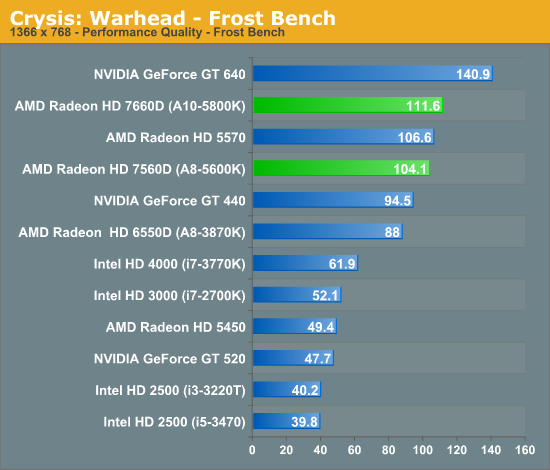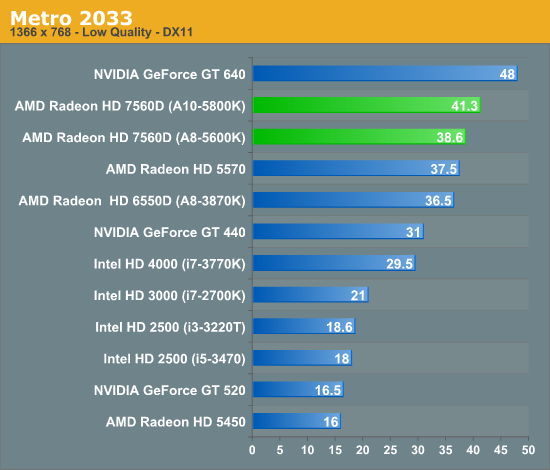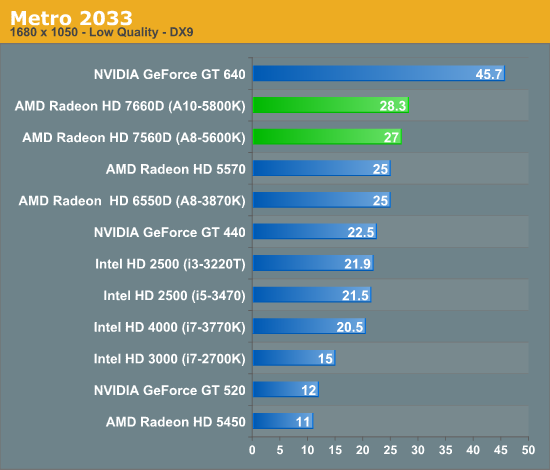AMD A10-5800K & A8-5600K Review: Trinity on the Desktop, Part 1
by Anand Lal Shimpi on September 27, 2012 12:00 AM ESTCrysis: Warhead
Our first graphics test is Crysis: Warhead, which in spite of its relatively high system requirements is the oldest game in our test suite. Crysis was the first game to really make use of DX10, and set a very high bar for modern games that still hasn't been completely cleared. And while its age means it's not heavily played these days, it's a great reference for how far GPU performance has come since 2008. For an iGPU to even run Crysis at a playable framerate is a significant accomplishment, and even more so if it can do so at better than performance (low) quality settings.



Crysis sets the tone for a lot of what we'll see in this performance review. The Radeon HD 7660D on AMD's A10-5800K boosts performance by around 15 - 26% over the top end Llano part. The smaller, Radeon HD 7560D GPU manages a small increase over the top-end Llano at worst, and at best pulls ahead by 18%.
Compared to Ivy Bridge, well, there's no comparison. Trinity is significantly faster than Intel's HD 4000, and compared to HD 2500 the advantage is tremendous.
Metro 2033
Our next graphics test is Metro 2033, another graphically challenging game. Like Crysis this is a game that is traditionally unplayable on many integrated GPUs, even in DX9 mode.



Metro 2033 shows us a 6 - 13% performance advantage for the top end Trinity part compared to Llano. The advantage over Intel's HD 4000 ranges from 20 - 40% depending on the resolution/quality settings. In general AMD is able to either deliver the same performance at much better quality or better performance at the same quality as Ivy Bridge.
The more important comparison is looking at the A8-5600K vs. Intel's HD 4000 and 2500. AMD is still able to hold onto a significant advantage there, even with its core-reduced GPU.










139 Comments
View All Comments
DanNeely - Thursday, September 27, 2012 - link
Does AMD share chipsets between their desktop and mobile platforms? AMD's done this for years (all of their desktop chipsets?); and all the legacy embedded devices you listed are typically connected via the LPC (low pin count) bus, a semi-parallelized implementation of the '80's era 8 bit ISA bus.jamyryals - Thursday, September 27, 2012 - link
I liked the sneak peak. I don't care if amd wants to hold off on the CPU benchmarks, they'll be out shortly anyways. It was already hinted at as what to expect by Anand in the article. The only thing that's troublesome is the people who take this as an opportunity to besmirch someone's credibility. Take a deep breath and in a few days you'll be able to justify your own viewpoint no matter what the numbers say anyways.At this point, it's more about the direction amd is headed that is interesting than this product. What is the target goal for this family of chips and will that be more successful than competing head to head with Intel.
Torrijos - Thursday, September 27, 2012 - link
In august an interesting article, treating of the influence of CPU was posted :http://techreport.com/review/23246/inside-the-seco...
The idea was not to measure average FPS, but instead to measure millisecond/frame for all the frames in a benchmark in order to see if performances were constant or would fall harshly for some frames (having a clear impact on playability).
The thing is with the current waive of CPUs with iGPUs it might be time to switch benchmarks to a similar methodology, in order to see which architectures handle the memory work better.
taltamir - Thursday, September 27, 2012 - link
I just did a double take, had to look twice, and indeed this is 100% a GPU benchmark with not a single test about the CPU.The only test relevant to the CPU might have been the AES acceleration (a fixed function test) and the power test (where intel still spanks AMD).
Jamahl - Thursday, September 27, 2012 - link
This is what happens when you look at the graphs without actually reading anything.Torrijos - Thursday, September 27, 2012 - link
I read the fact that they can't talk about CPU now, I was trying to say that FPS is an antiquated metric...My point was that APUs tend to share memory bandwidth between the CPU and GPU resulting in unreliable peak performances (even when coupled with a discreet GPU) while still maintaining a good average FPS.
In the end the FPS metric isn't the best available number to clearly evaluate performance of these chips. a full plot of milliseconds per frame for the entire test run offers a clearer vision.
An alternante measure would be % of frames that took more than XX milliseconds to generate.
James5mith - Thursday, September 27, 2012 - link
I know that the Desktop CPU has had more and more integration, but when did Anandtech decide to start calling them SoC's, as if they were the all-in-one packages inside a smartphone?It's still an APU, or CPU+GPU+IMC, or whatever you want to call it. It is not a complete system. It still needs a southbridge chipset for all the sundry interconnects.
SleepyFE - Thursday, September 27, 2012 - link
Will everyone please give up on the measuring competitions (referring to mine is bigger). I'm using Phenom 2 x2 555 and it works just fine 3 years running. I'm an average price conscious gamer. I look for 100€ CPU's and 150€ GPU's (right now i have 6870 Radeon). Everything i do works just fine with very high 2xAA settings. Having an i7 would make no difference in performance because games don't put more cores to good use and every other program i use can't even put a single core to good use.I will say again:"I AM AVERAGE!!" And it all works for me. ALL the CPU's right now are sufficient for the average man (or woman).
The reason AMD is stressing the GPU side of APU's is because that's what matters. When you can buy an APU for 200€ that has a HD Radeon x870 (x being the generation number) class GPU in it that saves me money and cancels one very loud fan. It's a win win.
jwcalla - Thursday, September 27, 2012 - link
"Average" people don't need a GPU any more powerful than what you'd need to drive a simple display. Because "average" people are nowhere near interested in PC gaming.And this is why AMD's strategy is a little silly.
The key to marketshare is making sweet deals with Dell, HP, etc.
jaydee - Thursday, September 27, 2012 - link
I noticed the motherboard has 3 digital video outputs and VGA. Can all three (DVI, HDMI, DP) be used at the same time with the APU?